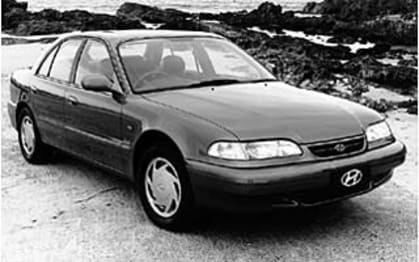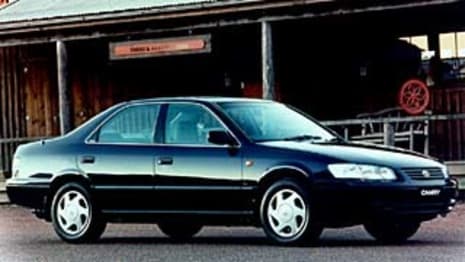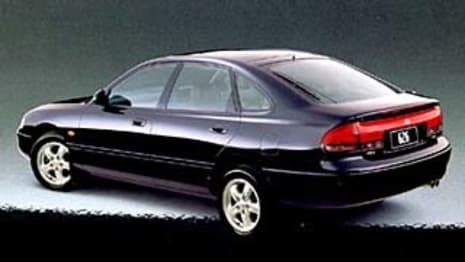
Used Hyundai Sonata review: 1998-2000
- Hyundai Sonata
- Hyundai Sonata 1998
- Hyundai Sonata 1999
- Hyundai Sonata 2000
- Hyundai Sonata Reviews
- Hyundai Reviews
- Hyundai Sedan Range
- Sedan
- Hyundai
- Used Car Reviews
- Buying tips
Hyundai paved the way for the Korean carmakers to enter the local market and in many ways paid the price for it. When Alan Bond first brought them in back in the 1980s they were cheap and cheerful cars that were written off as inferior with poor build quality, hand-me-down technology and uncertain durability.
In many ways they’re still carrying that tag even though the cars they’ve been selling in recent times are vastly improved.
Hyundai is also regarded by some as the ‘Excel’ car company; it was the model they used to gain a toehold in the local market, even though they’ve worked hard to grow beyond the small car segment.
The Sonata is a far cry from the Excel, but it is still thought of as cheap-and-cheerful.
MODEL WATCH
Hyundai had been so successful with its marketing of the Excel to cash-strapped buyers with its innovative drive-away pricing policy it became a victim of its own success when everyone came to expect the same deal with all of its models.
It became a problem when the company wanted to move beyond the small car segment and sell larger and more sophisticated models like the Sonata. For a time they simply didn’t sell, buyers perceived them as being of an inferior quality than the cars they were being sold against in the medium segment.
While car companies often promote minor upgrades as being “all-new” Hyundai had every right to label the 1998 Sonata new for just about everything was renewed in one way or another.
Most of the significant changes took place under the very Korean skin where it featured a new platform, new wishbone front suspension and a whole new family of V6 engines.
The combination of wishbone front suspension and multilink independent rear was right up to the minute in technology terms, it was the perfect package for good ride and handling, which for the most part it turned out to be.
Unfortunately much of the good work on the suspension was brought undone by the steering which had more kickback than had been seen for many years.
Hyundai offered a choice of four-cylinder and V6 engines, the latter a responsive double overhead camshaft 2.5-litre unit which gave 127 kW at 6000 revs and 230 Nm at 3750 revs and ensured it had plenty of zip.
The V6 was all new and got good reviews for its performance and fuel economy, while the double overhead camshaft four was carried over from the previous model and was also rated quite highly for its performance with 103 kW at 6000 revs and 180 Nm at 4600 revs.
All of that power was channelled to the front wheels through either a five-speed manual gearbox or, in most cases, a four-speed auto.
If the mechanical specification was praised there wasn’t the same ready praise for the Sonata’s styling, which tended to polarise opinion. Some loved it, others loathed it, as is the often the way with styling.
While still very Korean the Sonata was a little less challenging to western eyes than earlier models. Its lines were cleaner which made it more appealing.
The 2.0 GLE opened the range with plenty of standard features, including air-conditioning, keyless central locking, cloth trim, power windows and mirrors, 60/40 split-fold rear seat, and six-speaker sound.
When you ticked the Classique box you also got alloys, six-stacker CD sound and a rear spoiler.
The 2.5 GLS opened the V6 range and got everything the GLE got plus the V6 and a CD player.
At the top of the range sat the 2.5 Levant, which came with dual airbags, ABS, leather, power driver’s seat and cruise.
IN THE SHOP
Hyundais are generally quite reliable; they suffer few problems with the major mechanical components. If there is a consistent problem area it’s the electrics, which seem to be of a slightly inferior quality to their Japanese rivals.
Owners often report misfiring, sometimes even a complete flameout to mechanics, and it’s usually traced back to the ignition leads. Replace them and the problem goes away, but it can be a costly business to replace the rear leads, which are tucked away at the back of the east-west mounted V6.
Look for oil leaks around the engine, which can be costly to repair.
Also ask for a service record as some owners tended to by Hyundais because of their low price and ignored their need to be serviced.
IN A CRASH
Hyundai beefed up the body structure, doors and roof rails to better absorb the energy in a crash.
It also fitted a lap/sash seat belt to the centre rear, which is often just a lap belt in other cars, and driver and passenger airbags were standard on the top range Levant.
Other models missed out, which puts a dampener on the Sonata’s safety picture.
OWNERS SAY
Richard Kenny’s 2000 Sonata GLS V6 manual has done 69,000 km with few faults apart from the ignition leads, which required replacement at the 65,000 km service. He says he consistently gets a little over eight L/100 km around town, and it’s even more economical on long trips.
Lindsay Morgan’s 2000 V6 Sonata has done 98,000 mostly troublefree kilometres. So happy is he with it that he rates it the best car he’s owned. His only gripes are that the suspension needs to be beefed up for use in the bush and he’s not keen on the look of the grille.
LOOK FOR
• Challenging looks
• Good performance from four and V6
• Sound engineering overall
• Annoying kickback in steering
• Good ride and handling
• Electrical woes
• Airbags only on top model
THE BOTTOM LINE
Generally reliable, feature-laden, mid-sized sedan with mostly good road manners and performance.
RATING
65/100
Pricing guides
Range and Specs
| Vehicle | Specs | Price* | |
|---|---|---|---|
| GLE | 2.0L, ULP, 5 SP MAN | $2,640 – 4,070 | 1998 Hyundai Sonata 1998 GLE Pricing and Specs |
| GLS | 3.0L, ULP, 4 SP AUTO | $2,420 – 3,850 | 1998 Hyundai Sonata 1998 GLS Pricing and Specs |
| Levant | 3.0L, ULP, 4 SP AUTO | $2,860 – 4,510 | 1998 Hyundai Sonata 1998 Levant Pricing and Specs |
Other cars to consider
$2,640
Lowest price, based on third party pricing data
















